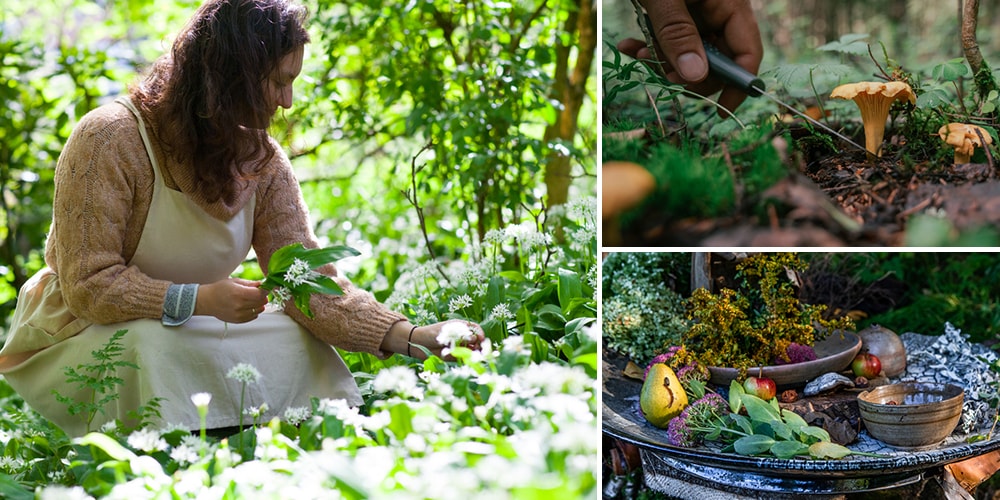
Deadly Mistakes Even the Most Experienced Foragers Make
Are you a seasoned forager, confidently trekking into the wild in search of nature’s bounty? Or perhaps you’re just starting to explore the world of gathering your own food from forests and fields. No matter where you fall on the spectrum, we can all agree that foraging is an exhilarating adventure filled with unparalleled rewards. However, even the most experienced foragers are not immune to making mistakes. In today’s blog post, we uncover these hidden dangers, ensuring both novices and experts alike stay safe.
How to Forage Like an Expert
Foraging, or the act of gathering wild food, has been a survival skill used by humans for centuries. It allows us to connect with nature and provides a sense of self-sufficiency. However, despite its many benefits, foraging can also be dangerous if not done correctly.
One of the main dangers of foraging is misidentification. Inexperienced foragers may mistake poisonous plants or fungi for edible ones. This is especially common in areas with diverse plant life where it can be easy to confuse similar-looking species. Additionally, plants can vary in appearance depending on factors such as location, age, and growth stage which makes identification even more challenging.
Another hazard of foraging is encountering wildlife. While most animals will typically avoid humans, some may perceive them as a threat and attack in self-defense. This is particularly true when collecting food from an animal’s habitat. This is what you should do if you come face to face with a bear, cougar or wolf.
Always wear appropriate clothing such as long pants and closed-toe shoes to protect against any potential encounters with wildlife or hazardous terrain. Bringing a first aid kit and informing someone of your location and estimated return time can also help in case of emergency.
Mistake #1: Not Correctly Identifying Plants
Consuming a poisonous plant can lead to serious health consequences such as nausea, vomiting, abdominal pain, and even death in extreme cases. Therefore, it is crucial to correctly identify plants before consuming them. This requires careful observation and knowledge of common edible plants in the area.
Poisonous plants have similar features to edible ones, making them difficult to differentiate without proper knowledge.
Additionally, some toxic plants may only cause harm when consumed in large quantities or prepared in specific ways. For example, many mushrooms have poisonous lookalikes that are only harmful if eaten raw or undercooked. Proper cooking techniques may neutralize their toxins, therefore, it is crucial to know how to prepare each type of mushroom correctly.
Smell and touch are also essential senses to use when identifying plants. Certain poisonous plants have distinct odors or produce a sticky sap that can irritate the skin upon contact.
Additionally, some edible plants may have non-edible parts that need to be removed before consumption, such as roots or seeds.
So how can one avoid this mistake? The key is preparation. Before heading out foraging, research the types of plants you expect to find in your desired area. Familiarize yourself with their distinguishing characteristics and any potential lookalikes.
When foraging, take your time to carefully examine each plant, paying attention to its leaves, stem, flowers, and fruits. Use a field guide or identification app to confirm your findings.
Examples of Commonly Mistaken Plants
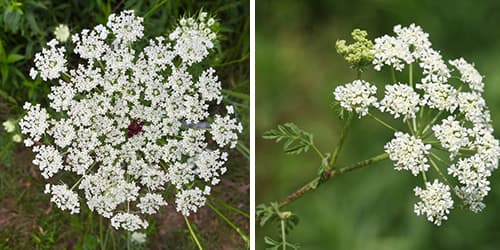
Poison hemlock (Conium maculatum) is often mistaken for wild carrot (Queen Anne’s lace) due to its similar appearance.
It contains a potent neurotoxin called coniine which affects the nervous system.
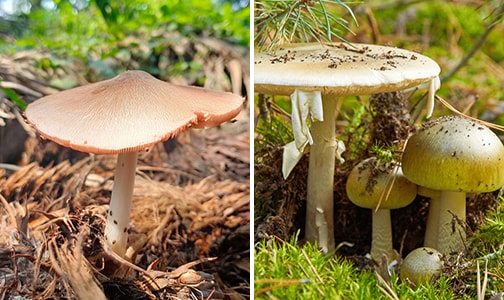
Mushrooms are a popular foraging item but can also be easily misidentified. The death cap mushroom (Amanita phalloides) is one of the deadliest mushrooms found in North America and is often confused with edible varieties such as the straw mushroom or paddy straw mushroom.
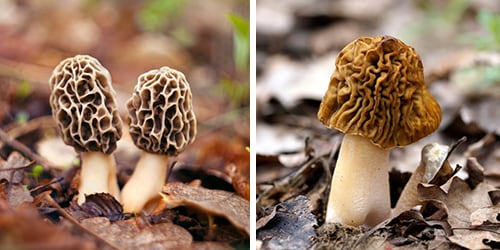
Similarly, the false morel (Gyromitra esculenta) looks very similar to true morels but contains a toxin called gyromitrin that can cause poisoning.
Here is a complete and easy guide to edible plants, berries, lichens, mushrooms and poisonous lookalikes.
Tips & Tricks for Correctly Identifying Plants
Do Your Research: Before venturing out to collect plants, it is important to do your research and familiarize yourself with the local flora. Look up pictures and descriptions of the plants you are interested in collecting, paying attention to distinct features such as color, shape, size, and texture. Take photos of the plant from different angles and compare them with images from reliable sources before consuming it.
Use Multiple Sources: When researching plants, it is always best to consult multiple sources to ensure accuracy. Different websites or books may provide varying information on a specific plant, so cross-checking can help identify any discrepancies.
Pay Attention to Habitat: Plants often grow in specific habitats that suit their needs. For example, some may thrive in wetlands while others prefer dry soil. Knowing the typical habitat of a plant can help narrow down its identity.
Observe Leaf Arrangement: The arrangement of leaves on a stem can provide valuable information about a plant’s identity. Leaves can be alternate (one leaf per node), opposite (two leaves per node), whorled (three or more leaves per node), or basal (growing from the base of the stem). This feature combined with other characteristics can aid in accurate identification.
Become Familiar with Poisonous Plants: While it is important to focus on learning about edible plants first, it is equally essential to familiarize yourself with poisonous ones as well. This will allow you to easily distinguish between safe and unsafe options when out foraging.
Use All Your Senses: When identifying plants, it is essential to use all your senses. Observe the plant’s appearance, smell its leaves and flowers, and even taste a small part if safe to do so. This multi-sensory approach can provide valuable clues about a plant’s identity.
Mistake #2: Foraging in Polluted or Contaminated Areas
Pollution and contamination can come in many forms, including chemical runoff from agriculture or industry, heavy metals from mining activities, and sewage or waste dumping. These substances can have harmful effects on both the environment and those who consume foods grown in contaminated areas.
One of the most common ways foragers encounter pollution is through water sources. Plants growing near bodies of water may absorb pollutants from the water and soil, making them unsafe to eat. This is especially true for plants that grow low to the ground, such as berries and mushrooms.
Another source of contamination is air pollution. Plants are natural filters, absorbing pollutants from the air around them. If you are foraging near urban areas or industrial sites, there may be a higher risk of contamination from airborne pollutants.
In addition to pollution, there are also risks associated with foraging in areas where chemicals have been sprayed or pesticides have been used. These chemicals not only harm insects but can also contaminate surrounding plant life. While these substances may not immediately kill off plants, they can accumulate over time.
Foragers should also be aware that certain plants have a natural ability to absorb toxins from their surroundings. For example, some species of mushrooms are known as “bioaccumulators,” meaning they absorb heavy metals such as lead and mercury from the soil around them.
So how do you avoid making this mistake? The key is to do your research before heading out on a foraging trip. Familiarize yourself with potential sources of pollution in your area by checking local environmental reports or speaking with experts at nature centers or botanical gardens.
Lastly but importantly, there is also an ethical aspect to consider when it comes to foraging. Over-harvesting certain plant species can have a detrimental impact on their growth and survival in the wild. It is essential for foragers to be mindful of sustainable practices and regulations in their area to ensure that they are not negatively impacting the environment.
How to Find Safe Foraging Locations
Research the Area: Look up the area you plan on visiting and find out if there have been any incidents of poisonous plants or dangerous wildlife in the past.
Avoid Areas with Pollution: Plants and fungi have the ability to absorb toxins from their surroundings, making them unsafe for consumption if they grow in polluted areas such as near factories, highways, or landfills.
Stick with Familiar Plants: It’s essential to only pick plants that you are familiar with or 100% sure of their identification.
Check Local Laws and Regulations: Some areas may have regulations or restrictions on foraging due to conservation efforts or safety concerns (e.g., national parks).
Ask Permission: If you plan on foraging on private property or someone else’s land, make sure you get permission from the owner first.
Remember, foraging is not dangerous as long as you know your plants. It is a cost-efficient and natural way of sourcing your own food and preparing healthy, free meals. If you want to learn more about the wild edibles growing in your area, plus easy recipes, get your copy of The Forager’s Guide to Wild Foods here.

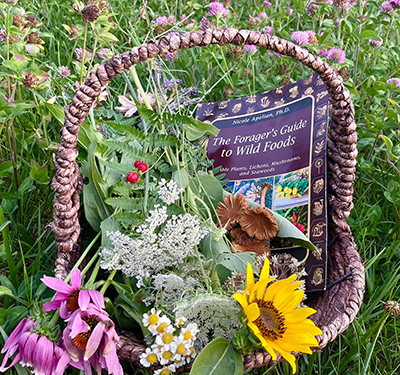
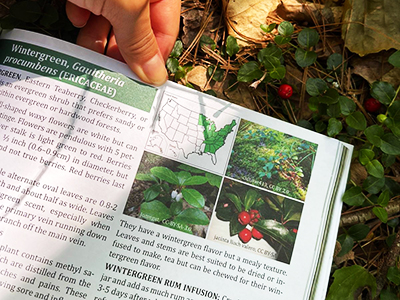
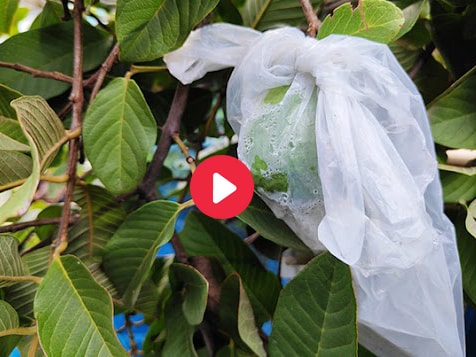
This is an awesome read for everyone, beginners and experienced.
Hi Brock,
Thank you for your kind feedback!
We’re happy to hear you enjoyed the article.
Many blessings and good health!
Hoi Shin, famous Chinese Herbalist,said that the only person that a herbalist ever accidentally kills should be himself. Meaning ,Don’t kid yourself about what you know.
Why can it not be shipped to Canada?
Hi Sue,
Thank you for supporting our work!
An email will be sent to you from support@thelostherbs.com with more information about our books, and the shipping policy.
Many blessings and good health!
I live at the base of a small mountain in nw Oregon, away from city and industrial pollution, surrounded by trees. I have a spring that runs year round off the hill into a pond. An acquaintance planted some pond weed to help protect the fish from the herron. It totally took over. I have researched various varieties of pond weeds, and have found a wide variety of opinions. The four varieties are very similar in growth patterns. Hydrilla to Parrot Feather. One, is considered a super food in some parts of the world. Parrot Feather grows wild and out of control in my pond. I have hoped that it is a nutritious plant, but I cannot find any information concerning it’s edibility. All the government sources tell how troublesome it is to boaters and swimmers, and how to get rid of it. Thanks to your information I have found many edible nutritious plants growing wild on my 8 acres, and I am thriving at age 82. If Parrot Feather is a super food, I have it made. I have tried to contact Nicole several times over the past year to learn more about Parrot Feather benefits, but I have yet to receive a reply.
Hi Alfie,
Thank you for your comment!
Some potential traditional uses or claims about Parrot Feather include:
Anti-inflammatory Properties: Some people believe that Parrot Feather may have anti-inflammatory properties, but scientific research supporting this claim is lacking.
Wound Healing: In traditional medicine, some aquatic plants are used for their potential wound-healing properties. However, specific evidence for Parrot Feather in this regard is not well-established.
Digestive Aid: In some traditional practices, aquatic plants are used as digestive aids. Still, there is no robust scientific evidence to confirm the digestive benefits of Parrot Feather.
Many blessings and good health!
Hi
Does it cover Australia.
Is it hard copy please?
Hi Peter,
Thank you for supporting our work!
An email will be sent to you from support@thelostherbs.com with more information about our books.
Many blessings and good health!
I have 2 kinds of muellen in my veggy garden, one with small leaves and small white flowers and one gigantic with hairy leaves with a huge stem with yellow flowers. I was wondering which one is having medicinal properties or are both good? It is hard to identify from your book. Thanks